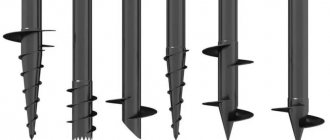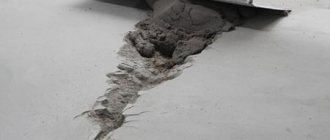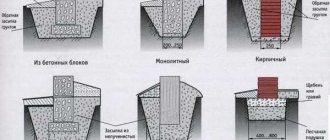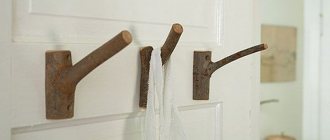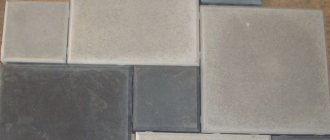Beton-House.com
Website about concrete: construction, characteristics, design. We combine the experience of professionals and private craftsmen in one place
Set of drills of different diameters
Concrete is the most versatile material used in home construction. Therefore, there are often cases when it is necessary to make holes in the concrete surface when laying cables or wires, installing equipment and furniture.
This cannot be done with a regular drill due to the high strength of the material. Only special concrete drills or drills can provide the required result. The article will tell you the types of tools, their features and methods of use.
Tool selection criteria
Tool sizes by diameter and length
To make the right choice of which drills to drill concrete with, you must first determine the volume and type of work to be performed.
To carry out small repair operations in your home, it is enough to use diamond drills with a diameter of 6 - 10 mm. If you need to hang a picture, it is better to take thinner tools with a diameter of 3 mm to 5.5 mm.
The diameter of the drill affects the depth of the mounting hole:
Dependence of diameter on drill length
According to GOSTs, all tools are marked, indicating the diameter and length, which helps to choose without error the size of the drill for a concrete screw to make a hole on a specific surface.
For example:
- Drill 6×110 mm. This is the most versatile and indispensable tool when making repairs in your homes;
- Drill 8×600 mm. Such long tools are used to drill deep holes;
- Drills 12×200 mm and 12×460 mm are used when it is necessary to drill holes for fastening furniture and laying electrical cables;
- Drill 24×460 mm. This drill is quite large in size and is often used when installing water supply and heating systems.
These are the main characteristics when choosing a drill. To learn in detail what types of tools there are for drilling and drilling holes in concrete, and how to choose the right ones for a particular case, you should watch the video in this article. Particular attention should be paid to the manufacturer.
Review of popular brands of tools for drilling holes in concrete
Drills used for concrete work are produced by foreign and domestic manufacturers. The cost of the instrument depends on the popularity of the brand.
How to choose the right drill bit for concrete?
Tip: When purchasing a tool, you should keep in mind that the higher the price of the product, the higher its quality and longer service life.
Good and durable tools are produced by foreign and Russian manufacturers. The best concrete drills are presented in the table:
| Manufacturer | Tool Features |
| High quality, durable and wear-resistant drills are tipped with carbide, retaining their properties even under prolonged loads that are accompanied by heat generation. Each drill is sandblasted and coated with titanium nitride, which increases their wear resistance. They are characterized by high elasticity and are resistant to bending and impact loads. A special sharpening of the solder makes it easier to insert the drill into concrete, and a spiral groove removes construction dust from the hole. |
| Rennbohr | High-quality metal is used to make the drill, and special processing protects the product from damage by corrosion. It has high strength and wear resistance, reliable protection against deformation. Retains its original shape over a long period of use. |
| Metabo | High quality, hard tipped, durable concrete drill bits. They have special heat resistance, are very durable, and have special grooves for quick removal of drilling waste. |
| Usually produced in a set of eight drills, of different diameters from 3 to 10 mm, packaged in a cardboard box. High-quality tool steel is used for production, and special processing protects against corrosion. Has high strength and wear resistance. It is not subject to deformation during frequent and long periods of operation. The U-shaped spiral on the tools helps to effectively remove dust when drilling a hole. The cylindrical shank securely secures the drill in the equipment chuck. |
| Tools with a four-spiral shape. This significantly reduces the time and labor required to remove concrete residue from a hole. |
| Tool Feature:
|
| The presence of a pobedite tip allows you to drill concrete and other building materials. The best option is to work in electric impact drills. |
| Anchor | They have an optimal price-quality ratio and a long service life. Products are made in China. They are equipped with durable carbide plates that are not destroyed even if the drill hits steel reinforcement when drilling concrete. However, you cannot drill through reinforcement with this drill. But when purchasing such a tool, you need to pay attention to the soldering of carbide plates - they must be even. |
| Used for rotary impact drilling. Peculiarities:
|
Advice: Which drills are best to use for concrete, everyone decides for themselves, based on their material capabilities. But it is always worth remembering that more budget options may be a fake, which can be immediately recognized when drilling concrete. Therefore, which drills are best to purchase, you should consult the seller.
Concrete drill bit for drill and hammer drill differences
To process concrete, you can use both a hammer drill and an impact drill. These two instruments differ not only in design, but also in purpose. An impact drill is designed for drilling into metal and wood, but can also be used for working on concrete. You can only work with a drill on concrete for a short time, otherwise the mechanism of the tool will quickly wear out and become unusable.
The hammer drill is designed for processing concrete, but can also be used for working with metal and wood, but only in short-term modes. The attachments for these tools differ in the design of their shanks. For a drill, the shank has a cylindrical design, and for a hammer drill it has a special shank with SDS type grooves. It is impossible to confuse the attachments, as well as to use them on instruments for which they are not intended. However, one can argue with this, since thanks to modern adapters, a drill bit for concrete from a drill can be installed on a hammer drill.
Drilling holes
The process of drilling a hole in concrete with an electric drill
The instructions for carrying out the work are quite simple:
- Working tools are carefully selected. With a hammer drill, due to the transverse runout, the hole is slightly larger in diameter; it is better to purchase a drill of a smaller diameter. A diamond bit cuts through concrete with minimal tolerances;
- The surface is marked for drilling holes;
- To clearly position the tool in the center of the hole, it is better to mark the starting point with a concrete punch or bolt;
- The tool is installed in a pre-designated recess and a hole is drilled in the concrete using a hammer drill;
Tip: When working with a rotary hammer or impact drill, a lot of dust is generated. Therefore, when drilling holes, you should use safety glasses, gloves and a respirator.
- Pressing with great force on the handle of the hammer drill, you gradually need to move deeper into the concrete;
- When drilling a sufficiently deep socket with a low-power impact drill, it is necessary to use several techniques, periodically cooling the drill;
- For large holes, you first need to go through the center of the intended hole with a drill of a smaller diameter, and with a more powerful one, expand the cavity to the desired size;
- Upon completion of processing, the cutting edges of the tool are inspected;
- If necessary, the drill is sharpened.
Drill sharpening
Drill cutting edge
Tip: When starting to make holes in a concrete wall, it is necessary not only to choose a high-quality tool, but also to use it correctly.
In this case, you need effective preparation of the drill, which consists of sharpening it. You can do this yourself on a sharpener with a corundum whetstone.
The operating technology is similar to restoring the cutting edge of any similar tools, but taking into account some nuances:
- Severe overheating of the surfacing should not be allowed. Exposure to high temperatures reduces the adhesion of the winch and the steel base, which reduces the strength of the connection;
- If the moment was missed and the drill got hot, it takes enough time for it to cool down so that the process occurs slowly. It is forbidden to immerse the instrument in water: due to temperature changes, cracks will appear on it;
- The drill is sharpened along a cone, or along a helical surface. In the first case, no additional devices are required;
- When sharpening to a conical shape, the edges should meet exactly in the center of the drill. If the intersection of the edges shifts: the tool will be pulled to the side during operation, and one of the edges will become blunt much faster;
- It is better to use screw sharpening when working on foam or aerated concrete, and the working part of the tool should be sharpened on a special sharpening machine.
Drill design
The design of the drill is quite standard. It consists of standard components such as a shank, cutting elements and chip removal elements. Made from alloys of increased hardness, the tip resembles the letter T.
Such tips are used when working with hard materials (metals, concrete, marble). To avoid confusion, it is better to look at a photo of a concrete drill.
Some of the best concrete drills are Pobedit drills. Pobedit is a special alloy of tungsten and cobalt, but quite a long time ago this alloy ceased to be used due to its high cost and was replaced by cheaper and higher-quality analogues.
The pobedite drill is presented on the market in very large quantities, but the brand name of the drill itself is not indicated on the description, which means that you can select it yourself based on your experience or the knowledge of the seller.
If you see drills with strange Chinese symbols, it is better to avoid this purchase, since they will only last for a couple of minutes of work (at best).
There is one tradition, the essence of which is to wet the tip of the drill (or the entire drill bit) with water. Some argue that this procedure will preserve the drill and lead to better work without breakage. But as production researchers found out, cooling the drill does not affect its operation in any way.
Also, a Pobedit drill can be sharpened quite easily, but this must be done carefully - there is a risk of overheating the drill and breaking off part of it. This should be done when the drill becomes dull.
Some useful tips when working with a drill
To drill a concrete surface with your own hands without any problems, you should follow the advice of experts.
Some of them can be found below:
- Before you start working on concrete, you should stock up on drills for different materials, including metal. This is because concrete drills are only used for drilling holes in concrete, ceramic, stone and other hard materials. But often, when entering concrete, the drill encounters metal reinforcement. This requires the use of a metal drill, which temporarily replaces the concrete tool used to drill through the reinforcement and then put the old one back;
- During operation, it is necessary to constantly monitor the temperature of the tool. Every 15 seconds of continuous drilling, you need to pause to cool the drill, but only naturally, without the use of water or other liquid;
- If, when entering concrete, the drill rests on a hard stone, it is better to use a punch, crush the stone, and then continue working with the same tool;
- If it is necessary to make a hole in the ceiling or load-bearing wall, it is better to replace the impact drill with a hammer drill;
- If drilling ceramics, use a concrete drill, but turn off the impact drill mode to prevent splitting of the tiles;
- A dull drill can be sharpened using a grinder by installing a diamond disc on it. If you purchase high-quality expensive tools for work, they will not need to be sharpened.
Tips on what and how to choose drills, concrete drills, and how to use them are useful for both beginners and experienced craftsmen. Drilling concrete is quite difficult, so it is better to first take into account all the recommendations of specialists and choose the right working tool.
Drilling concrete
The main purpose of a cutting tool in domestic conditions is to create holes with a diameter of up to 6 mm and a depth of up to 100 mm in a concrete or brick structure. The latter material is inferior in strength to concrete, and is also more fragile. Therefore it is easier to process.
Limitations on diameter and depth are related to the technical capabilities and operating mode of the impact drill. Unlike a hammer drill, which punches a hole, a drill drills out (scrapes out layer by layer) a hole. Making rotational movements, the drill simultaneously works as a punch. Such operations were performed earlier, before the advent of the impact mode, according to an excellent scheme - a drill drilled, a person manually operated a punch and hammer.
Another feature is the frequency of impacts. A hammer drill applies an order of magnitude less force, but an order of magnitude stronger. The noise from the sound of a drill can be roughly compared to the loud itching of a mosquito. Another feature is that the younger brother operates at high speeds, which contributes to the rapid failure of the drill and the tool itself.
Recommendations for using a concrete drill
- You must not overheat the drill; the indicator is a change in color tone, even blue tones. Cooling in air, possibly in a draft or under a fan, but not in water or oil. The use of a prohibited procedure will lead to the loss of technical properties of the solder and drill.
- The presence of a stone is not a reason to interrupt the drilling operation completely. A hand punch and hammer will help here.
- Metal in the form of reinforcement or embedded parts is drilled with the same drill, but in normal mode (without impact), and with a classic drill of the same diameter.
- When working with a concrete base, the drill must be given a slight force along the main axis. But don’t overdo it, or you might screw up the drill.
- Metal, wood or other soft and viscous material cannot be processed with a concrete drill. Firstly, a different sharpening angle. Secondly, the tip hits the workpiece during operation - this operation is intended for fragile materials (brick, concrete).
A concrete drill is an affordable tool and a good assistant for home repairs, but it is necessary to correctly evaluate the technical capabilities of the cutting and power tool. Then, a more expensive tool, a hammer drill, may not be needed.





